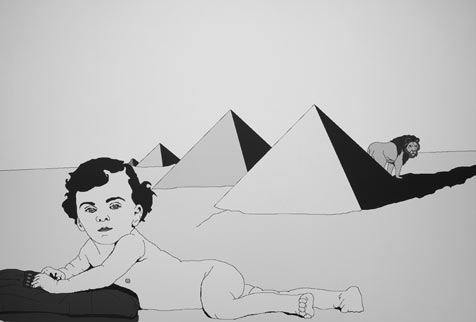Setareh Shahbazi: Why Not Bazar
At the Contemporary Arts Forum.

Iran-born, Berlin-based artist Setareh Shahbazi takes photographs and collects pictures from commercial sources, then modifies these images digitally before printing them for display. For this body of work, the digitization shows up mostly as simplification-contours are flattened into expanses of a single color and lines are exaggerated as black boundaries, often inflected by the presence of the digital distortion effect known as aliasing. Single subjects appear against monochromatic backgrounds on unframed panels. The juxtaposition of images allows Shahbazi to form enigmatic, rebus-like symbolic statements. As with the title of the show, there is something deliberately unfinished and open-ended about the arrangements, which exist as fragments of an implied conversation.
The artist has identified the subject of her work as the experience of traveling back and forth between the Middle East, Western Europe, and California. Her most recent solo exhibition prior to this one was at a gallery in Hamburg, but in 2005 Shahbazi was artist-in-residence at the Townhouse Gallery in Cairo, Egypt, and the year before that she spent time in Beirut, Lebanon.
Although she avoids showing the horrors of war directly, Shahbazi has opened a fascinating window onto the psychology of life in the shadow of armed conflict. The pleasures alluded to in the images of happy children and exotic birds have been flattened and processed by fear, losing their nuance and reality. Set beside the mundane architecture of the increasingly homogenous global-built environment, the figures in these pictures become ciphers, full of meaning on one side, and seemingly empty on the other. Like the recurring empty movie screen that appears in several of the panels, Shahbazi’s semiotic arrays suggest an appalling suspension or exile within the time just before or just after significance.
The show’s two most charged images occupy opposite corners of the space. In the rear of the main gallery, a simple black stencil on the wall depicts what appear to be three chickens hanging from a curtain rod. In the front of the side gallery, a single panel shows the face of the artist grafted onto the body of an infant, lying in front of the pyramids. The artist as baby sphinx is an apt metaphor for this tantalizing riddle of a show that manages to serve up the terror and the boredom of contemporary life as unlikely twins.



